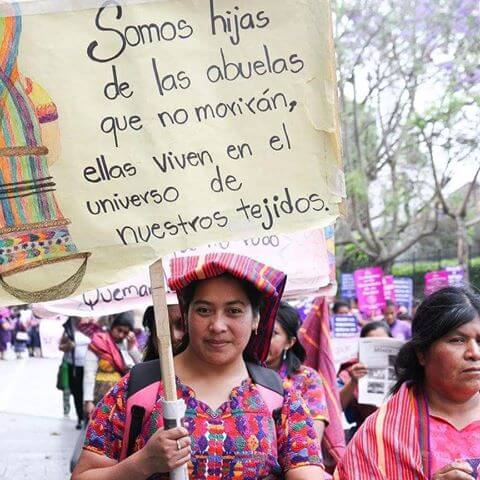The Other Story of Huipiles

"We are daughters of the grandmothers who will not die, they live in the universe of our weavings."
Most likely you are familiar with the beautiful traditional blouses worn by Maya women, called huipiles (pronounced whip-peals, sometimes written "güipiles"). The blouses are one of a kind, handwoven on a backstrap loom, each usually taking at least a couple of months to complete. Perhaps you are also familiar with some of the history, that different communities have different huipiles, and that a huipil can signify social status or have ceremonial significance. They are an important part of Maya cultural identity that dates back to pre-hispanic times. Currently, huipiles are at the root of two very different social justice struggles. First, there is the struggle to protect the traditional designs from being appropriated by domestic or international fashion designers or factories; secondly, there is the struggle to make sure the weavers receive a fair payment for their used or “recycled” huipiles.

AFEDES (Asociacion Femenina para el Desarrollo de Sacatepequez), a group of women weavers from Santiago Sacatepequez in Guatemala have been working to organize their community to protect their collective intellectual property rights. Positioning their weaving designs as more than just designs but as part of their cultural identity, they have presented Initiative 5247 to the Guatemalan Congress. If it is passed into law (and there are still many challenges ahead), it would result in collective recognition as well as the need for permission and/or compensation to the indigenous weavers for the use of their designs.
Back in August, AFEDES went to Quetzaltenango to organize more women into the movement. Mayamam Weavers and two other women’s groups from Cajola sent representatives. Along with protecting their intellectual rights, the movement seeks to educate and organize Maya women, who have been excluded for the most part from much of Guatemalan society. They will be investigating the cultural history of their textiles among other activities. Our Maria Vail will serve as representative to the movement on an ongoing basis.

The other social struggle is to educate consumers both in Guatemala and internationally about the reality behind their purchases of “recycled” huipiles that have been made into bags or skirts or belts or whatnot. “Recycled” brings a U.S. consumer social stamp of approval, currently it’s a hot trend. We as consumers feel good about a purchase that says “recycled” because we think we are saving something from the landfill. Recycled huipiles however, are a very different story. Many Maya women living in poverty are forced to sell their huipiles at a fraction of their value in order to pay for their child’s school, medicine or to put food on the table. “Middle men (or women)” travel to villages going door to door pressuring these women to sell their huipiles for only $3 or $4 and in turn resell it to businesses who cut them up to make purses, shoes, backpacks and more. In this case, the huipiles are often sold by weight not taking into consideration the detail or patterns that each huipil has. Giving up their huipil leads to many problems. The women are losing a piece of their identity as they give up part of their traditional dress (they replace their huipil with an inexpensive factory made blouse) and the work of the backstrap weavers continues to be devalued. While many of these blouses may be labeled “fair trade,” the informed buyer has to try to understand where the huipil originally came from and if the weaver or owner was paid a fair price.

For more information on this topic,
Recycled Huipiles: Unraveling Traditions?
"Textiles are the books that the colony was not able to burn"
"These Mayan weavers could be paving the way for indigenous communities to trademark their work"
"Maya weavers propose a collective intellectual property law"



Comments
Caryn Maxim
Thank you Maria for y our comment. We are not familiar with the specific issue that you refer to, but I am not surprised. I am sorry I cannot give you any contacts, we are located in Guatemala so have not kept up with this issue in Mexico. As you read, there is a struggle going on in Guatemala to protect their designs…but it is a long term and difficult challenge. Thank you for your interest! Caryn
August 04, 2020
Maria Autran
You probably know about Poppa Holt business of selling Mexican Huipils and changing the original name to sell it in Euros. I am curious what rights she has acquired to legally change the name and have Mexican artisans make the Huipils to her but selling her on her website under her name/brand. In addition there are allegations that those indigenous people are not paid a fair share. Has anyone look into this? To me it a clear violation of collective intellectual property rights and it should be followed up legally.
July 20, 2020
Barbara Davs
I lived in Guatemala in 1981 & 82. I bought many beautiful Guipiles. 35 years later I have decided to donate them to a museum. They are preserved and being admired by many now. I feel better.
March 06, 2019
Leave a comment